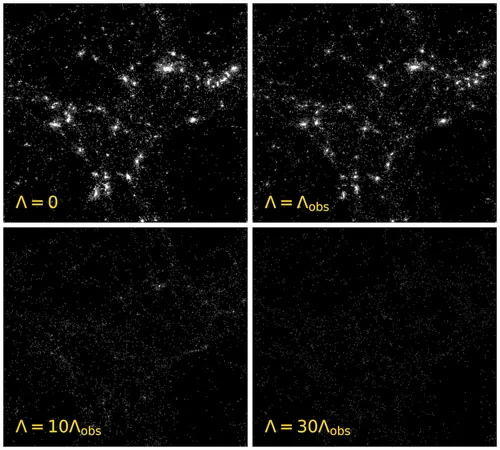
Unlocking the Secrets of Cosmic Life: A Revolutionary Model for Estimating Intelligent Beings in the Universe
2024-11-13
Author: Charlotte
Unlocking the Secrets of Cosmic Life: A Revolutionary Model for Estimating Intelligent Beings in the Universe
Scientists have recently unveiled a groundbreaking theoretical model that estimates the probability of intelligent life emerging across the universe and potentially in various hypothetical universes. This innovative approach, which echoes the famed Drake Equation devised by Dr. Frank Drake in the 1960s, aims to deepen our understanding of life's formation in the cosmos.
Drake's original equation calculated the number of detectable extraterrestrial civilizations within our Milky Way galaxy. Fast forward over six decades, and a team of astrophysicists from Durham University has presented a new model that shifts the focus from mere star counts to the universe’s accelerating expansion and the interplay with dark energy—a mysterious force constituting more than two-thirds of the universe.
The Intriguing Calculations
The new model does not aim to predict a precise number of intelligent observers in the universe but rather assesses how the properties of the universe influence the chances of life arising. By examining the density of dark energy and its role in star formation, researchers have uncovered some astonishing insights. The study indicates that a typical intelligent observer would likely exist in a universe with substantially higher dark energy density than our own, challenging the notion that our universe is the most conducive for the emergence of life.
In analyzing the history of star formation, the study reveals that while our universe has approximately 23% of ordinary matter converted into stars, a universe optimized for star production could reach as high as 27%. This profound difference underscores that our universe may not offer the best odds for the development of intelligent beings.
The Role of Dark Energy in Our Existence
Dr. Daniele Sorini, the study's lead researcher, emphasized the monumental challenge of understanding dark energy and its implications for our universe. "The parameters governing our universe, including dark energy density, could hold the key to explaining our existence," he noted. Surprisingly, the research indicates that even a significantly higher density of dark energy could still support life, perhaps indicating that our universe is merely one of many pathways through which life can evolve.
The interplay between dark energy and gravitational forces permits both the expansion of the universe and the formation of celestial structures. It's vital, however, for matter to cluster sufficiently to form stars and planets, lasting long enough to allow complex life to emerge.
Implications for Astrophysics
The implications of these findings are vast, as the model could pave the way for understanding how different dark energy densities affect cosmic structures and the potential for life. According to co-author Professor Lucas Lombriser of the Université de Genève, the model invites excitement about exploring the emergence of life in various universes, potentially reshaping our understanding of fundamental cosmological questions.
Reviving the Drake Equation
While the Drake Equation provided a framework for searching for extraterrestrial life, it relied on estimates that could often feel abstract. This new model integrates more fundamental astrophysical principles, connecting yearly star formation rates with essential cosmic ingredients like dark energy density. Collaborating scientists from the University of Edinburgh and the Université de Genève are set to delve deeper into how these insights could change our perspective on life in the universe.
In a world fascinated by the search for extraterrestrial life, this new model not only enhances our comprehension of cosmic formation but also sparks curiosity about the unknown—could there be countless universes with conditions perfectly suited for intelligent beings? The quest for answers is far from over, and humanity's place in the cosmic landscape remains as intriguing as ever.









 Brasil (PT)
Brasil (PT)
 Canada (EN)
Canada (EN)
 Chile (ES)
Chile (ES)
 España (ES)
España (ES)
 France (FR)
France (FR)
 Hong Kong (EN)
Hong Kong (EN)
 Italia (IT)
Italia (IT)
 日本 (JA)
日本 (JA)
 Magyarország (HU)
Magyarország (HU)
 Norge (NO)
Norge (NO)
 Polska (PL)
Polska (PL)
 Schweiz (DE)
Schweiz (DE)
 Singapore (EN)
Singapore (EN)
 Sverige (SV)
Sverige (SV)
 Suomi (FI)
Suomi (FI)
 Türkiye (TR)
Türkiye (TR)